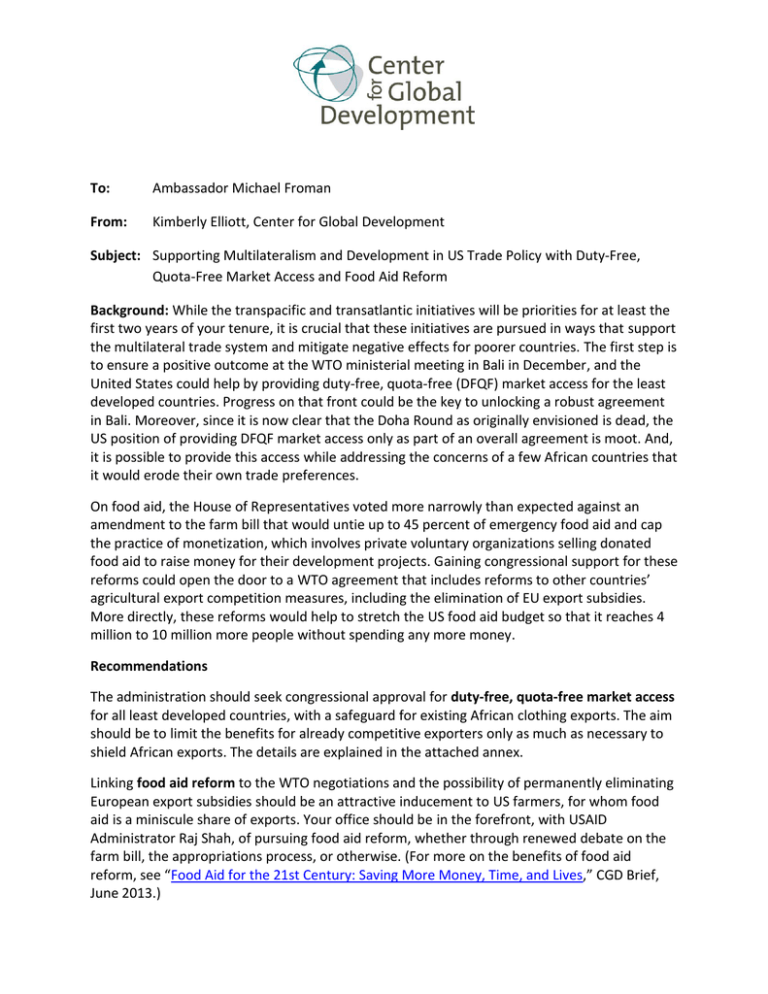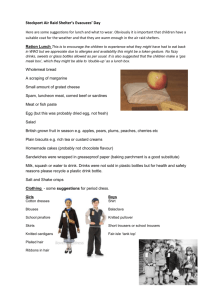To: From: Subject:
advertisement

To: Ambassador Michael Froman From: Kimberly Elliott, Center for Global Development Subject: Supporting Multilateralism and Development in US Trade Policy with Duty-Free, Quota-Free Market Access and Food Aid Reform Background: While the transpacific and transatlantic initiatives will be priorities for at least the first two years of your tenure, it is crucial that these initiatives are pursued in ways that support the multilateral trade system and mitigate negative effects for poorer countries. The first step is to ensure a positive outcome at the WTO ministerial meeting in Bali in December, and the United States could help by providing duty-free, quota-free (DFQF) market access for the least developed countries. Progress on that front could be the key to unlocking a robust agreement in Bali. Moreover, since it is now clear that the Doha Round as originally envisioned is dead, the US position of providing DFQF market access only as part of an overall agreement is moot. And, it is possible to provide this access while addressing the concerns of a few African countries that it would erode their own trade preferences. On food aid, the House of Representatives voted more narrowly than expected against an amendment to the farm bill that would untie up to 45 percent of emergency food aid and cap the practice of monetization, which involves private voluntary organizations selling donated food aid to raise money for their development projects. Gaining congressional support for these reforms could open the door to a WTO agreement that includes reforms to other countries’ agricultural export competition measures, including the elimination of EU export subsidies. More directly, these reforms would help to stretch the US food aid budget so that it reaches 4 million to 10 million more people without spending any more money. Recommendations The administration should seek congressional approval for duty-free, quota-free market access for all least developed countries, with a safeguard for existing African clothing exports. The aim should be to limit the benefits for already competitive exporters only as much as necessary to shield African exports. The details are explained in the attached annex. Linking food aid reform to the WTO negotiations and the possibility of permanently eliminating European export subsidies should be an attractive inducement to US farmers, for whom food aid is a miniscule share of exports. Your office should be in the forefront, with USAID Administrator Raj Shah, of pursuing food aid reform, whether through renewed debate on the farm bill, the appropriations process, or otherwise. (For more on the benefits of food aid reform, see “Food Aid for the 21st Century: Saving More Money, Time, and Lives,” CGD Brief, June 2013.) Annex: A Pragmatic Proposal to Extend Market Access to All LDCs Clothing is the most important sector excluded from the US Generalized System of Preferences for developing-country imports. This proposal focuses on how that sector could be included in a duty-free, quota-free market access program while also shielding the existing preferential access enjoyed by eligible African countries under the African Growth and Opportunity Act and Haiti under amendments to the Caribbean Trade Partnership Act. 1. Set two percent of total imports in a sector as the threshold for competitive LDC exporters Sector 1: HTS 61 Articles of Apparel or Clothing Sector 2: HTS 62 Articles of Apparel or Clothing Accessories, Knitted or Crocheted Accessories, Not Knitted or Crocheted Million Share of total US Million Share of total US Exporter dollars imports in sector Exporter dollars imports in sector China 14,948 36.41% China 14,655 40.03% Vietnam 4,141 10.09% Bangladesh 3,304 9.02% Indonesia 2,832 6.90% Vietnam 2,867 7.83% Honduras 2,147 5.23% Mexico 2,528 6.91% Cambodia 1,788 4.35% Indonesia 2,122 5.80% El Salvador 1,591 3.88% India 1,823 4.98% Mexico 1,316 3.21% Italy 918 2.51% India 1,249 3.04% Sri Lanka 751 2.05% Bangladesh 1,019 2.48% Cambodia 725 1.98% Pakistan 977 2.38% Nicaragua 947 2.31% Guatemala 914 2.23% Note: LDCs are highlighted Source: US International Trade Commission, Trade Dataweb at http://dataweb.usitc.gov/. 2. For competitive exporters, exclude 32 detailed (10-digit) tariff lines that account for 80% of AGOA clothing exports, as well as all tariff lines with exports greater than $5 million for Kenya, Lesotho, and Mauritius, countries that account for 87% of all AGOA apparel exports. 6102302010 W coats, jackets 6103431520 M trousers, MMF 6103431540 B trousers, MMF 6103431550 M shorts, MMF 6104622006 W trousers, cotton 6104622026 G trousers, cotton 6104622030 W shorts, cotton 6104632006 W trousers, MMF 6104632011 W trousers, MMF 6105100010 M shirts, cotton 6105202010 M shirts, MMF 6109901007 M t-shirts, MMF 6109901050 W t-shirts, MMF 6110202040 M/B sweatshirts, cotton 6110202069 M/B pullovers, cotton 6110202079 W/G pullovers, cotton 6110303053 M/B pullovers 6110303059 W/G pullovers, MMF 6204624006 W corduroy trousers, cotton 6204624011 W jeans 6204624021 W trousers, cotton 6204624041 G jeans 6204624051 G trousers, cotton 6203424011 M jeans 6204633510 W trousers, 6203424016 M trousers, cotton MMF, not knitted 6203424036 B jeans 6205202051 M shirts, cotton 6203424046 B trousers, cotton 6205202066 M shirts, cotton 6203424061 B shorts, cotton 6209203000 Babies’ trousers, cotton NG: W=women’s; G=girls’; M=men’s; B=boys’; MMF=manmade or synthetic fibers. See also “Restoring US Leadership on Trade and Development,” CGD Brief, March 2013.




